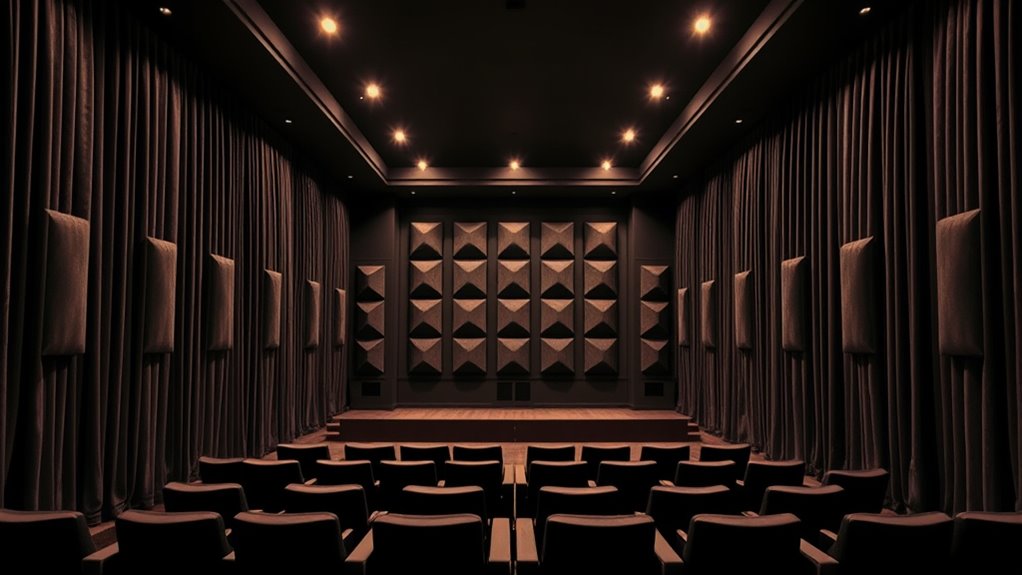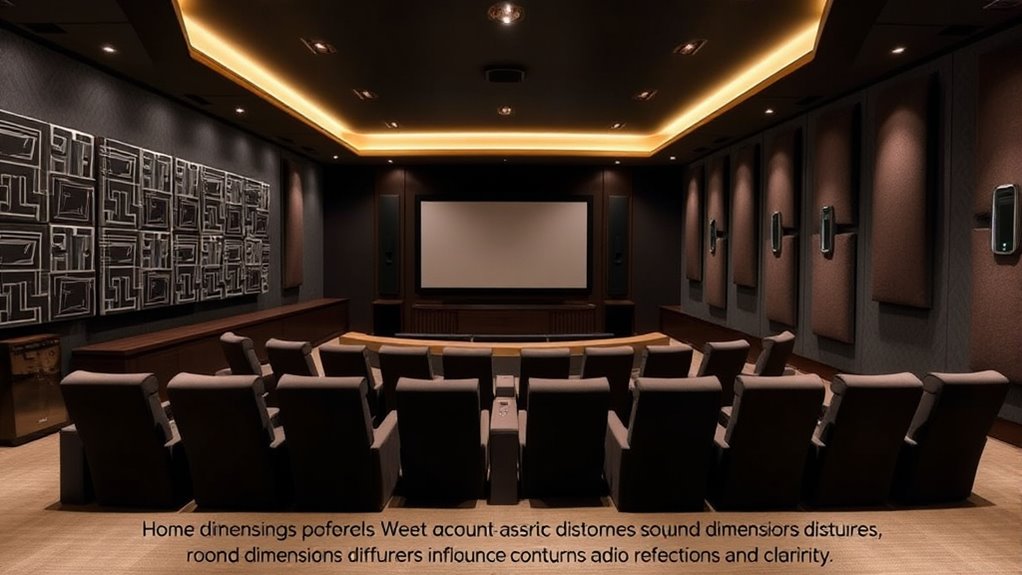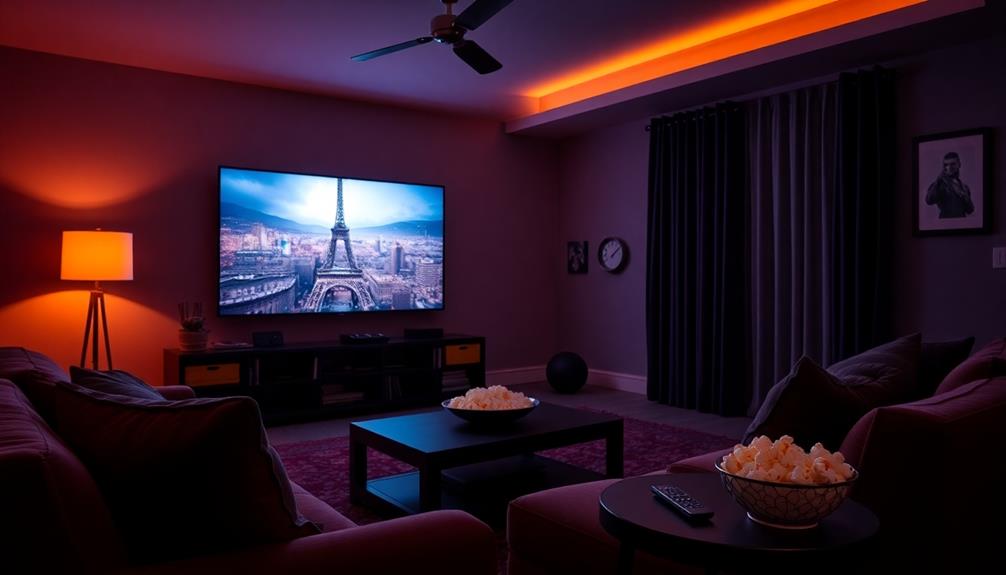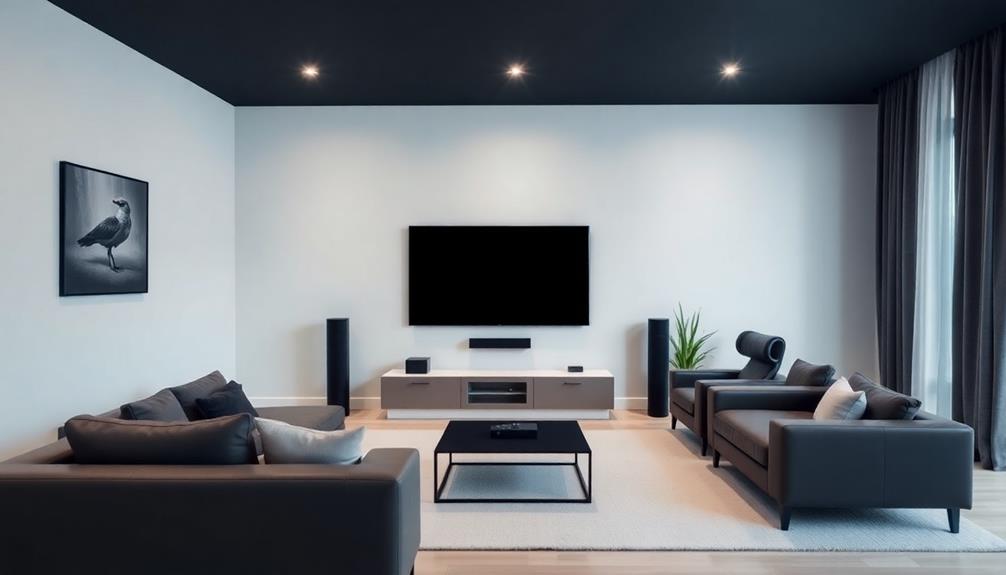Your home theater’s sound quality depends heavily on its size and shape. Larger rooms can create a spacious feel but may cause sound to dissipate and echo if not treated properly. Small rooms can intensify sounds, risking muddiness. The shape affects how sound reflects, with non-parallel walls reducing problematic echoes. Understanding how room proportions and design influence acoustics helps you optimize clarity and immersion—keep exploring to learn how you can perfect your space.
Key Takeaways
- Larger rooms enhance spaciousness but require sound diffusion to prevent echo and dead zones.
- Rectangular or parallel-walled rooms can cause problematic reflections and standing waves.
- Higher ceilings improve sound diffusion and reduce low-frequency resonances for clearer audio.
- Non-uniform room shapes help scatter sound waves, minimizing echoes and hotspots.
- Properly balanced room proportions prevent resonance issues, ensuring better sound clarity and immersion.

The size and shape of your home theater room play a crucial role in determining sound quality and overall acoustics. When designing or setting up your space, understanding how these factors influence audio performance can help you achieve a more immersive experience. Larger rooms tend to provide a spacious feel, but they also pose challenges with sound dispersion. If your room is too vast, sound waves may dissipate before reaching your ears, creating a sense of emptiness or echo. Conversely, a smaller space can intensify sound but might result in a crowded or muffled experience if not properly treated. Striking the right balance involves considering both dimensions carefully.
The shape of your room impacts how sound waves reflect and interact within the space. Rectangular rooms are common, but they often cause problematic echoes and standing waves due to parallel walls. These waves can create hotspots—areas with exaggerated sound levels—and dead zones with little audio activity, disrupting the balance you want. To mitigate this, you can introduce asymmetry or angles into your room’s design, which helps scatter sound waves more evenly. Non-parallel walls reduce the likelihood of standing waves forming, leading to cleaner, more consistent audio across your listening area.
Additionally, the height of your ceiling influences acoustics considerably. Higher ceilings tend to diffuse sound better and prevent the buildup of low-frequency resonances, but they also require more careful treatment to avoid echoing. Lower ceilings might make the room feel more intimate, but they can trap sound, causing muddiness or boominess if not properly managed. Incorporating ceiling treatments such as diffusers or absorbers can help balance these effects, ensuring sound waves disperse evenly without excessive reflection.
Your room’s proportions also matter. Rooms with a cubic shape can amplify certain frequencies, resulting in a boxy or boomy sound. To counteract this, consider incorporating elements like angled walls, strategic placement of furniture, or acoustic treatments that break up these resonances. The goal is to create a space where sound can move freely and reflect in controlled ways, enriching your listening experience rather than muddling it. Paying attention to room dimensions and their influence on sound behavior can make a significant difference in optimizing acoustics, especially by understanding how the shape of the room interacts with sound waves. Implementing acoustic treatments tailored to your space can further enhance overall sound clarity and balance.
Frequently Asked Questions
How Does Ceiling Height Influence Home Theater Sound Quality?
Ceiling height considerably impacts your home theater sound quality. Higher ceilings can create a more spacious and immersive experience by allowing sound waves to travel freely, reducing echoes. However, if the ceiling is too high, sound may dissipate, causing a loss of clarity. Conversely, lower ceilings can concentrate sound, enhancing dialogue clarity but possibly making the space feel more confined. Proper acoustic treatment balances these effects for ideal sound.
Can Irregular Room Shapes Improve Acoustic Performance?
Imagine your room as a concert hall, with irregular walls acting like skilled conductors guiding sound waves. An irregular shape scatters reflections, reducing echoes and dead spots, creating a more immersive experience. You’ll notice clearer dialogue and richer sound because the uneven surfaces break up standing waves. So, yes, irregular room shapes can enhance acoustic performance by turning your space into a dynamic, lively music venue rather than a dull echo chamber.
What Materials Best Absorb Sound in Small Home Theaters?
In small home theaters, you want materials that effectively absorb sound to reduce echo and improve clarity. You should consider acoustic panels, foam tiles, or thick curtains, as they trap sound waves and prevent reflections. Carpets and plush furniture also help absorb noise. Avoid hard surfaces like glass or bare walls, which reflect sound. Using these materials creates a balanced environment, enhancing your overall viewing and listening experience.
How Do Door and Window Placements Affect Acoustics?
You might think doors and windows don’t impact sound, but they actually do. Proper placement can prevent sound leaks and echoes, keeping audio clear. If you position doors and windows away from the main listening area, you reduce disruptions. Sealing gaps and using heavy curtains or acoustic treatments around openings further improves sound quality. So, carefully plan their location to create a more immersive and balanced home theater experience.
Is There an Ideal Room Size for Optimal Surround Sound?
You might wonder if there’s an ideal room size for perfect surround sound. While larger rooms can enhance sound immersion, they also pose challenges like echo and sound dispersion. Smaller spaces may produce clearer audio but can feel cramped. The key is finding a balance, ensuring your room isn’t too big or small, and optimizing placement, acoustics, and equipment to achieve the best surround sound experience for your space.
Conclusion
In designing your dream home theater, don’t overlook the importance of room size and shape. Small spaces can create sound chaos, while larger rooms might lack intimacy. By balancing your space’s size with thoughtful shape choices, you’ll craft a cozy, clear, and enthralling cinematic experience. Remember, shaping your space smartly ensures sensational sound, seamless acoustics, and stunning sights—making your home theater truly a sanctuary for sensational sound and spectacular sights.
Hello, I’m Art, and I’m excited to be a part of the 1Home Theatre Projector team. As a writer, I’m here to contribute my knowledge and insights to help you achieve the ultimate home cinema experience. I understand that making decisions in the world of home entertainment can be complex, and I’m here to simplify the process for you.
















